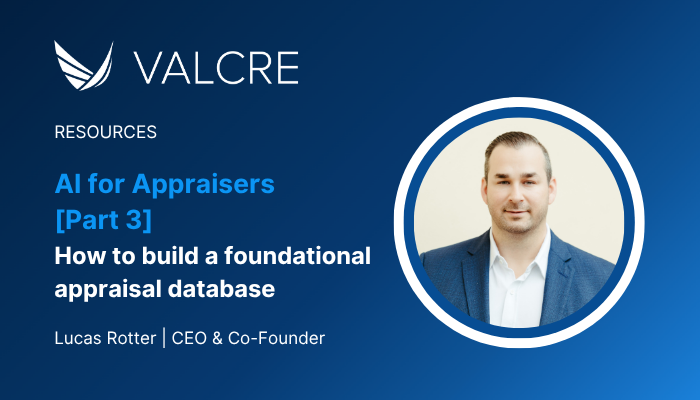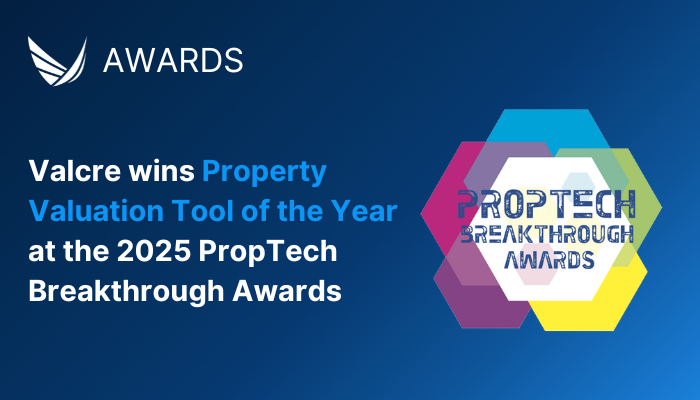
AI is here for appraisers. It’s no longer a question of if but how to adopt it.
As appraisers grapple with the reality that emerging AI technologies are here to stay, many in the profession are uncertain about how they can practically use AI tools, and the first steps they need to take into this new realm.
In Part 1 of this series, we explored how AI can dramatically improve accuracy and efficiency in both general business operations and core appraisal workflows. In Part 2, we broke down how to evaluate AI vendors using three essential principles: agility, accuracy, and trustworthiness.
But here’s the truth: even the best AI solutions are worthless without clean, structured data.
If you’re serious about bringing AI into your appraisal workflow, the first and most important step is this:
Get your data house in order.
In this post, we’ll cover:
- What a foundational database is and why it matters
- The current state of most appraisal data (and why it’s a problem)
- How to start organizing your data
- Long-term storage options and trade-offs
The Problem: Disorganized, scattered, unsearchable data
When we start working with a new appraisal team at Valcre, we often see the same scenario:
- Data scattered across years of Excel files, PDFs, and Word documents
- Reports saved on local hard drives or lost in email threads
- Critical property info locked inside static files or even physical binders
- The valuable data is unstructured, disorganized and not uniform
What does this mean for appraisers in practical terms? It means that the valuable property information collected, in some cases, over decades, is very difficult to actually make use of. Say an appraiser is looking for a comparable for a property with a net rentable area of 1,000 to 2,000 square feet. Existing reports can’t be easily searched – the appraiser needs to know what they’re looking for or go through every document to find comparables that fit.
This data situation makes it incredibly difficult and time consuming for your team to find the information they need to do their jobs. It also means there’s no way for you to actually make use of the next generation of powerful AI tools.
In a messy data environment, there’s no easy way to find what you need unless you already know exactly where to look. That’s wasted time—and missed opportunity.
The Goal: A structured, searchable, centralized database
A foundational database is the opposite of chaos. Its:
- Structured: Key fields, such as property addresses, net rentable areas, and land size are organized in a clear, consistent schema with specific categories.
- Standardized: The relationship between each field and record should be well-defined and obvious, and make sense in the context of commercial real estate.
- Validated: Before being entered, the information should be validated, scrubbed, and normalized, with inconsistencies removed, giving users confidence in the integrity of the data they’re using. For example, instead of everyone on your team describing a lot shape in multiple ways (e.g. square, rectangular), a database would have specific parameters so everyone is on the same page.
- Accessible: The database is digitally hosted (i.e. in the cloud), so that it is easily accessible to every appraiser on the team, regardless of their location.
With this foundational database in place, your team can:
- Instantly filter for relevant comps
- Easily analyze trends in historical data
- Power AI tools that enhance productivity and insights
Storing your data in this way not only gives you a foundation on which to run your AI, at a fundamental level it ensures that your team is actually able to capitalize on the incredibly valuable data you have at your fingertips.
For example – instead of asking around for a set of properties with a specific net rentable area, they can simply filter by area and get a full list with corresponding information including location and other defining characteristics.
Start small, start today
Understandably, it may sound like a big effort to establish a formal database, particularly if you’re working with years worth of legacy data.
But every appraisal business has to start somewhere, and the more you delay, the further you’ll fall behind in your ability to capture the immense benefits that AI technology can offer your business.
The good news is that you can simplify the process and get started with the projects you’re working on today, as opposed to trying to wrangle years of disorganized data right off the bat.
The easiest way to kick off is to establish a simple Excel spreadsheet where your team can enter property data into a table in an organized and uniform format. Then add additional rows of data for every record you wish to track.
The fields in your spreadsheet should be consistent and capture the general characteristics of a property that are specific to commercial real estate appraisal – such as property address, net rentable area, land area, and year built.
Database Options: Start simple, scale smart
Option 1: Excel spreadsheet
This is a great starting point for small teams or sole proprietors
Pros:
- Easy to set up and implement
- No new software needed
- Compatible with AI tools like ChatGPT for simple queries [for example, give me X number of properties with X rentable square feet.]
Cons:
- Poor scalability across teams
- Limited filtering and search capabilities
- Risk of version control issues
Still, it’s the best first step, and it’ll make transitioning/upgrading to a more robust system much easier later.
Option 2: Third-party database (like Valcre)
Once you’re ready to scale, a professional cloud-based appraisal database is the logical next move.
Pros:
- Predefined schema tailored to CRE appraisal
- Built-in advanced search, filtering, and reporting
- Secure, cloud-based access for distributed teams
- Dedicated support and onboarding for importing legacy data
Whether you migrate directly or start from Excel, Valcre can help import and normalize your existing files to build a powerful, AI-ready database.
Why it matters: The foundation for AI success
A database will change the way your team capitalizes on your valuable information.
Without clean data, AI simply doesn’t work. But with a well-structured database, your team unlocks:
- Appraisers save time finding comps and past projects
- Insights can be surfaced automatically through AI
- Report turnaround times drop
- Accuracy and defensibility improve
For example, one Valcre client in Texas reduced comp search time by 40% after implementing their foundational database.
A database also builds the foundation for your future AI roadmap; from comp recommendations and report writing to analytics and business intelligence.
With your database established, you open up a whole new world of possibilities for your team when it comes to how they interact with and utilize your data. Importantly, you’ll also establish a solid foundation on which to build out your AI toolset and join the next generation of appraisers leveraging technology to increase their production and deliver superior reports that match their clients’ increasing expectations.
On an end note, it’s important to realize that while implementing a database successfully is certainly an achievement, it’s only going to be effective if your team actually uses it.
What’s next?
Building a database is a major milestone. But to truly succeed, your team needs to actively use it. In Part 4, we’ll explore:
- How to drive internal adoption
- The keys to successful change management
- How to align your team around the long-term value of AI
At Valcre, we’re already working with leading appraisal teams to structure their data and unlock AI-powered workflows. Want to see what’s possible? Request a demo to talk to our team today.


![AI for Appraisers [Part 4]: Managing change for a successful AI rollout](https://www.valcre.com/wp-content/uploads/Blog-featured-image-–-AI-Content-Series-May-2025-8.png)